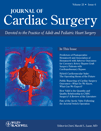Fate of the Aortic Valve Following the Arterial Switch Operation
Conflict of interest: None.
Presented at the Society of Heart Valve Disease 5th Biennial Meeting Berlin, June 29, 2009.
Abstract
Abstract Objective: We evaluated the long-term outcome of aortic valve after arterial switch operation (ASO). Methods: A retrospective review of 324 hospital survivors after ASO was performed. Echocardiographic findings and incidence and progression of aortic regurgitation (AR) were investigated. Endpoints of the study were the first documented occurrence of moderate or severe AR or need for aortic valve replacement (AVR). Results: Upon discharge from hospital 5.2% of the patients showed mild AR, progressing to 11.4% after 1 year. At a mean follow-up time of 14.4 ± 0.54 years, AR was absent in 307 (94.7%), trivial in six (1.8%), mild in nine (2.7%), and moderate-to-severe in two (0.6%) patients. There is a progression of AR with time after ASO (p < 0.001). A total of two patients reached the combined endpoint, both of whom underwent AVR at a mean time of 10.82 years after ASO. Freedom from aortic valve reoperation was 98.7 ± 0.9% at 5 and 10 years and 94.7 ± 4% at 15 years. Univariate analysis identified the following risk factors: ventricular septal defect (VSD) (p = 0.005), prior pulmonary artery banding (p < 0.003), and postoperative incidence of mild AR (p < 0.0001). Conclusion: AR is not rare after ASO, but it is stable without progressive intensity; new AR developed in 5.2% after 10 years, and is present only in 2.7% after a median follow-up 14.4 ± 0.54 years. If trivial AR is excluded, it is present only in 0.9%. New AR can develop even up to 15 years. However, severe AR and need for AVR are rare. (J Card Surg 2010;25:730-736)




